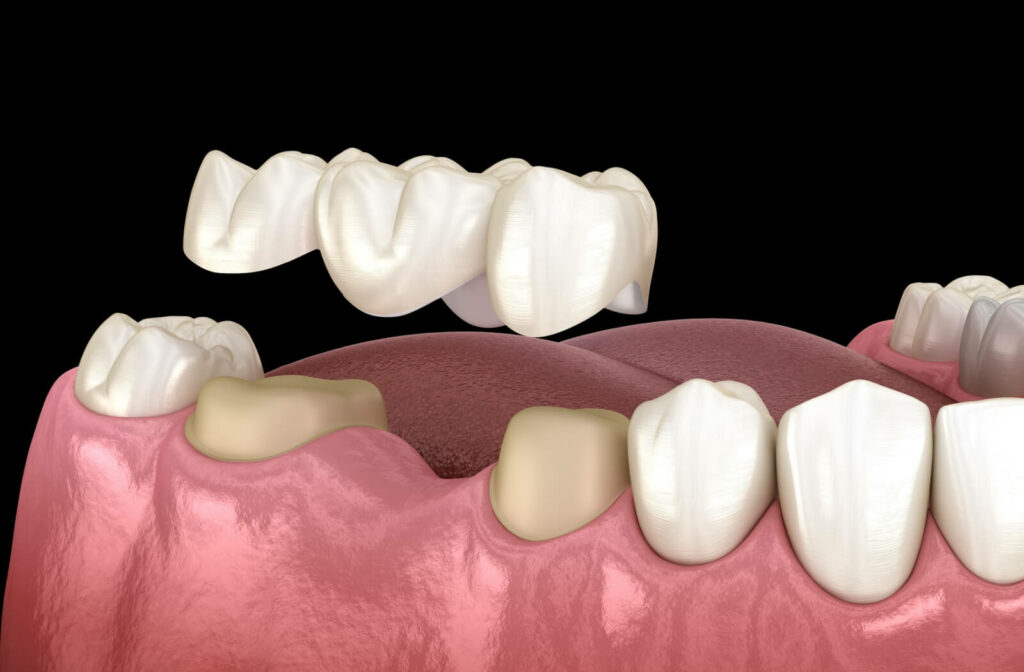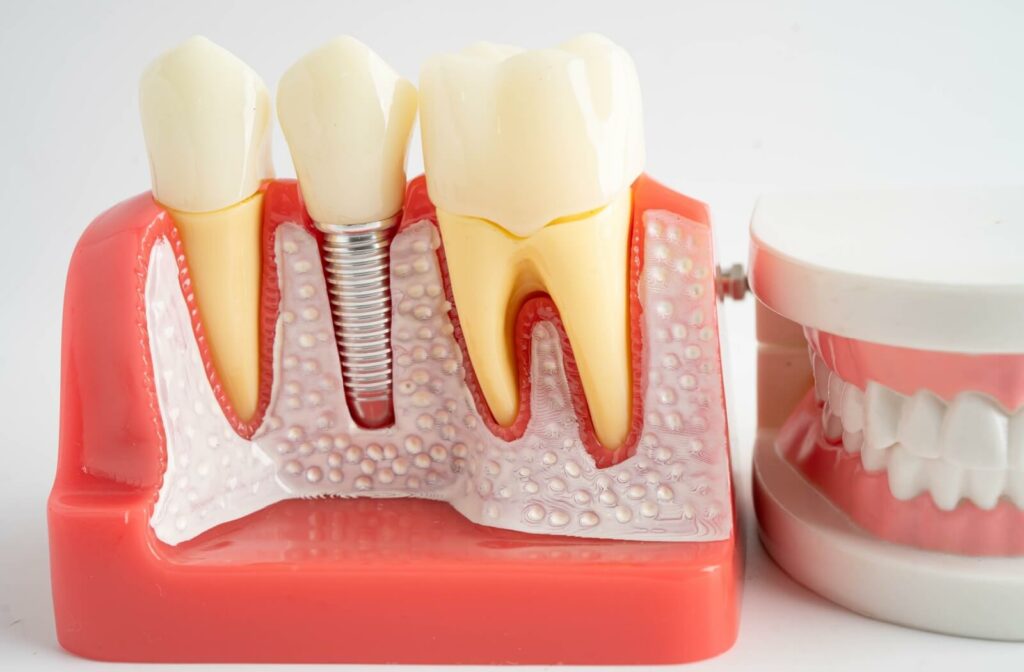If you’re missing a tooth, you’ve likely come across 2 popular dental solutions during your research: tooth implants and dental bridges. There isn’t a one-size-fits-all answer to which is the better solution, as both implants and dental bridges aim to restore your smile, improve functionality, and prevent further oral health issues. They just do it differently.
For example, a tooth implant can be a more permanent solution, but it requires sufficient bone density. Alternatively, a dental bridge can still be a long-term solution that is more flexible in terms of the number of teeth it can replace.
What You Should Know About Tooth Implants
Tooth implants, also known as dental implants, are a modern and highly durable solution for replacing missing teeth. They’re designed to mimic the structure and function of a natural tooth, making them a popular long-term choice for many people.
The Implant Process
The process of getting a tooth implant typically involves 3 stages:
- Placement of the implant post: A titanium post, which serves as the artificial root for your tooth, is surgically inserted into the jawbone. This process ensures a solid foundation for the replacement tooth.
- Healing and osseointegration: Over the next 3 to 6 months, the jawbone fuses with the implant in a process known as osseointegration. This creates a stable base for the crown.
- Attachment of the tooth: Once the implant has fully integrated, a custom-made tooth is attached, completing the process and restoring the natural appearance of your smile.
Benefits of Tooth Implants
- Durability: With proper care, implants are designed to be permanent, although the artificial tooth or crown may eventually need to be replaced.
- Bone health: Implants prevent bone loss by stimulating the jawbone where the tooth is missing.
- Natural appearance: Crowns are designed to look and feel just like real teeth.
- Oral hygiene: Implants allow you to maintain your natural brushing and flossing routine.
An Overview of Dental Bridges
Before the rise of implants, dental bridges were the go-to solution for replacing missing teeth. Unlike implants, bridges aren’t anchored directly into the jawbone, but rely on the adjacent teeth for support.

The Bridges Process
Similar to implants, getting a dental bridge involves multiple steps:
- Preparation of adjacent teeth: The teeth on either side of the missing tooth (called abutment teeth) are prepared by reshaping them.
- Custom bridge creation: A bridge consisting of 1 or more artificial teeth is custom-made to match your smile.
- Bridge placement: The bridge is secured onto the adjacent teeth using dental cement or similar adhesive, restoring both function and visual appeal.
Benefits of Dental Bridges
- Quick solution: The process is faster than implants, often completed in just 2 visits.
- Cost-effective: Bridges are generally more affordable upfront compared to implants.
- Restores functionality: Chewing and speaking are improved.
- Aesthetic results: Modern bridges are designed to blend seamlessly with your natural teeth.
Longevity of Bridges
While dental bridges offer a reliable solution, they usually last between 5 to 15 years. Longevity is influenced by factors such as oral hygiene, biting habits, and regular dental care.
Key Differences Between Tooth Implants & Dental Bridges
Now that we’ve covered the basics of implants and bridges, how do they compare in key areas?
Lifespan
- Tooth implants: Typically last a lifetime with proper care.
- Dental bridges: Need replacement every 5 to 15 years on average.
Costs
- Tooth implants: Although they have a higher initial cost, they offer long-term savings due to their durability.
- Dental bridges: Offer a lower upfront cost, but may require replacement over time, which can add to the total expense.
Maintenance
- Tooth implants: These require regular brushing, flossing, and dental check-ups, similar to natural teeth.
- Dental bridges: Extra care is needed to clean under the bridge, which may involve special flossing tools.
Aesthetics
- Tooth Implants: Natural-looking and indistinguishable from real teeth.
- Dental Bridges: Modern bridges also look natural but may not match the seamless appearance of implants over time.
Who Is the Ideal Candidate for Each Option?
With pros and cons to each, let’s explore who the ideal candidate is for each dental solution.
Ideal Candidates for Tooth Implants:
- People with good overall oral health and sufficient jawbone density.
- Anyone seeking a permanent, low-maintenance solution.
- People who want to avoid affecting adjacent teeth.
Ideal Candidates for Dental Bridges:
- People with weak jawbone density that’s unsuitable for implants.
- Those looking for a quicker, more affordable solution.
- Candidates who may not want to undergo surgical procedures.
It’s important to consult with your dentist to determine which option suits your specific needs and oral health condition.
Making the Right Choice for Your Smile
Choosing between a tooth implant and a dental bridge ultimately depends on your priorities, such as longevity, budget, and personal preferences.
If you’re still unsure which option is best for you, contact our expert team at Upper Gage Dental Centre to request an appointment to discuss your unique needs. After all, your smile deserves the best care possible.



